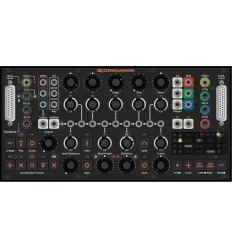Video Synthesizers
A video synthesizer is a device that electronically creates a video signal. A video synthesizer is able to generate a variety of visual material without camera input through the use of internal video pattern generators. It can also accept and "clean up and enhance" or "distort" live television camera imagery. The synthesizer creates a wide range of imagery through purely electronic manipulations. This imagery is visible within the output video signal when this signal is displayed. The output video signal can be viewed on a wide range of conventional video equipment, such as TV monitors, theater video projectors, computer displays, etc.
Video pattern generators may produce static or moving or evolving imagery. Examples include geometric patterns (in 2D or 3D), subtitle text characters in a particular font, or weather maps.
Imagery from TV cameras can be altered in color or geometrically scaled, tilted, wrapped around objects, and otherwise manipulated.
A particular video synthesizer will offer a subset of possible effects.
Video Synthesizers as Real Time performance instruments
The history of video synthesis is tied to a "real time performance" ethic. The equipment is usually expected to function on input camera signals the machine has never seen before, delivering a processed signal continuously and with a minimum of delay in response to the ever-changing live video inputs. Following in the tradition of performance instruments of the audio synthesis world such as the Theremin, video synthesizers were designed with the expectation they would be played in live concert theatrical situations or set up in a studio ready to process a videotape from a playback VCR in real time while recording the results on a second VCR. Venues of these performances included "Electronic Visualization Events" in Chicago, The Kitchen in NYC, and museum installations. Video artist/performer Don Slepian designed, built and performed a foot-controlled Visual Instrument at the Centre Pompidou in Paris (1983) and the NY Open Center that combined genlocked early micro-computers Apple II Plus with the Chromaton 14 Video Synthesizer and channels of colorized video feedback.
Analog and early real time digital synthesizers existed before modern computer 3D modeling. Typical 3D renderers are not real time, as they concentrate on computing each frame from, for example, a recursive ray tracing algorithm, however long it takes. This distinguishes them from video synthesizers, which must deliver a new output frame by the time the last one has been shown, and repeat this performance continuously (typically delivering a new frame regularly every 1/60 or 1/50 of a second). The real time constraint results in a difference in design philosophy between these two classes of systems.
Video synthesizers overlap with video special effects equipment used in real time network television broadcast and post-production situations. Many innovations in television broadcast equipment as well as computer graphics displays evolved from synthesizers developed in the video artists' community and these industries often support "electronic art projects" in this area to show appreciation of this history.
Source: Wikipedia





